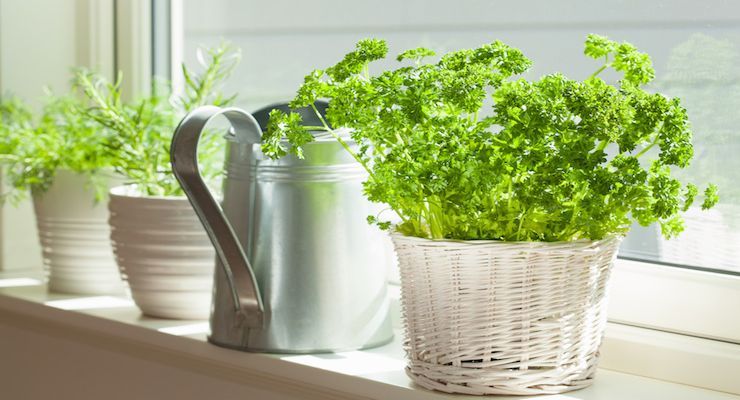Winter can often be a rough time for the avid gardener. The temperature cools, flowers begin to wither, the green fades from your garden, and snow blankets the sleeping plants. But thankfully, just because the Jack Frost has made his appearance, doesn’t mean you have to stop enjoying fresh herbs for the winter season. Take advantage of your home’s natural warmth and light, and grow fresh herbs for health and healing even in the midst of a raging blizzard.
Using herbs as medicine dates back thousands of years. Throughout ancient civilization, herbs have been utilized to help alleviate coughing, sore throat, runny nose, burns, and soothe itchy skin. Not to mention that the presence of fresh greenery brightens your home, cleans the air, and improves the overall atmosphere of your indoor space.
Basil
Basil is one of the easiest herbs to grow inside. Not only can it be used to add flavor to soups and sauces, but due to its natural antibacterial and anti-inflammatory properties, it can also provide excellent relief from various ailments. Use this herb to soothe a cough, reduce irritation from bug bites, and settle the stomach. Mix 2 tablespoons of fresh basil with 1 cup boiling water and let steep for 5 minutes. Strain, add honey if desired, and sip. Rub salve on topically for skin issues.
Catnip
Your cats will grow crazy for this beneficial herb. Be sure to keep this plant in a high location if you have adventurous kitties. Catnip can help relieve headaches, reduce stress tension, relax the body, and even reduce menstrual cramps. Whip up a cup of catnip tea and enjoy the potent flavor. Add honey if desired.
Thyme
Thyme works wonders for your immune system and can help your body fight off those nasty winter bugs. This fragrant herb relieves stress and contains potent antibacterial and antiseptic properties. It also promotes restfulness and can limit the effects of insomnia.
Lavender
Lavender is well known for its ability to bring calm and relaxation. Even just the scent of fresh lavender in your home can provide a deep level of harmony and balance to the chaos of an average day. Running your hands over your lavender plant and breathing in will release the soothing scent, while a tea brewed from this purple plant can help you unwind after a long day.
Peppermint
Perhaps one of the most well-known and commonly used herbs for various ailments, peppermint has long been proven to be a medicinal powerhouse. Plus, it is incredibly hardy, so even the most amateur gardener should have no problem growing this plant. Anytime you begin to experience stomach upset, reach for a cup of freshly brewed peppermint tea. It can help alleviate symptoms from indigestion, motion sickness, morning sickness, and menstrual cramps. It also reduces the intensity and duration of headaches.
Lemon balm
Lemon balm is a mild sedative and can help take the edge off mild anxiety and depression. It relaxes the entire nervous system, just enough to keep you calm, without making you drowsy or reducing performance capabilities. This herb is also a potent mosquito repellent and can be made into various sprays and even added to candles for the upcoming mosquito season.
Parsely
As with other herbs, this one serves a dual purpose. It is an excellent choice for culinary purposes, yet also delivers potent medicinal relief. Parsley can be used to reduce your chances of developing a urinary tract infection, as it works to support your internal organs.
Sage
Growing sage indoors is not only easy but is incredibly beneficial as well. It contains astringent and antiseptic properties that help aid digestion and soothe a sore throat. The oils present in sage can also prove helpful in the healing of various mouth sores and painful ulcers. Simply brew a cup of sage tea or chew on a few leaves to reap the benefits.
Growing tips
- Make sure to provide adequate sunlight for your herbs. Invest in an artificial grow light if necessary.
- Ensure that pots have sufficient drainage holes
- Fertilize regularly according to the instructions of each plant
- Harvest frequently to encourage new growth
- Water as often as needed to keep the soil moist
Happy planting!
-Susan Patterson

